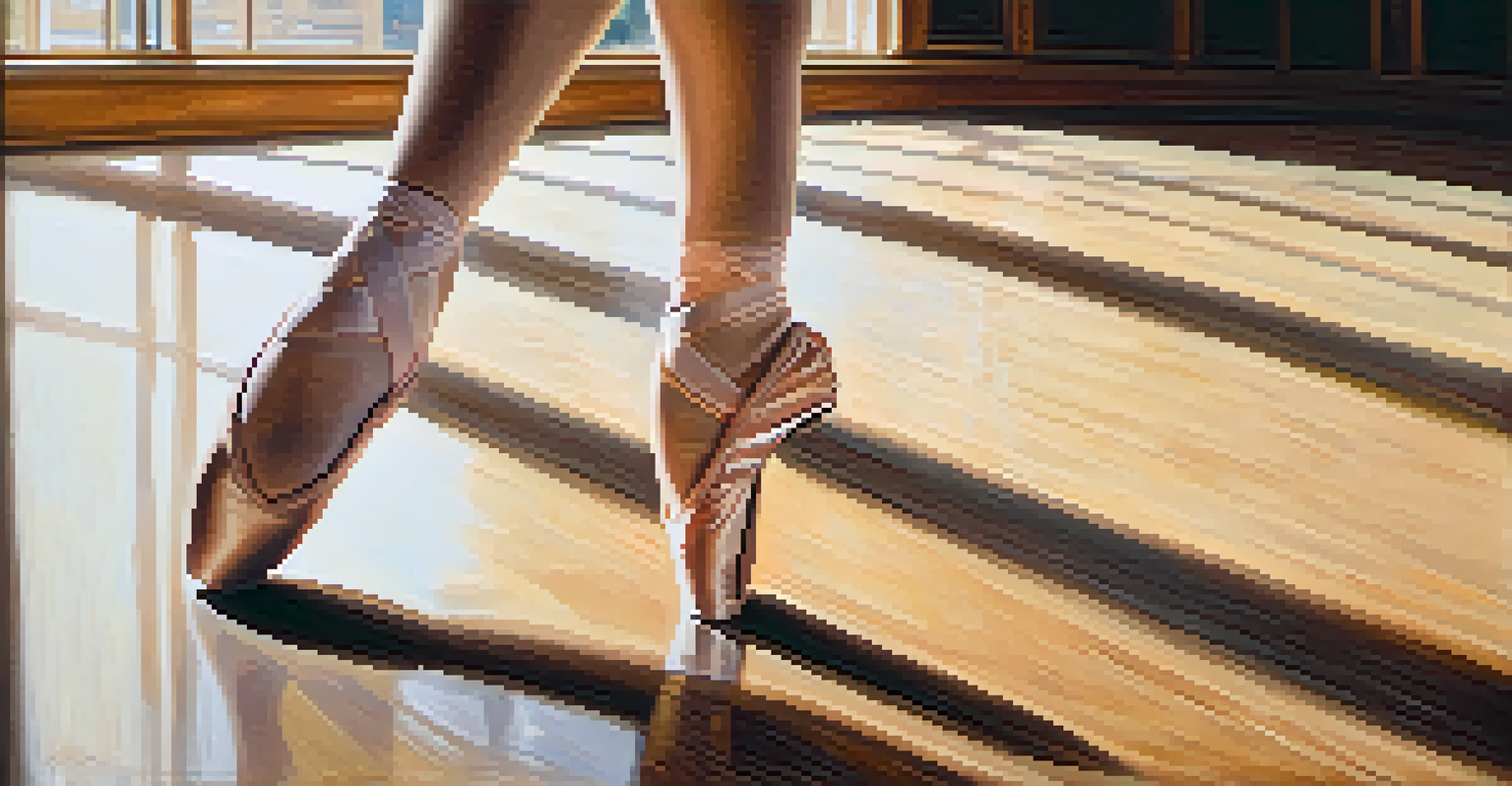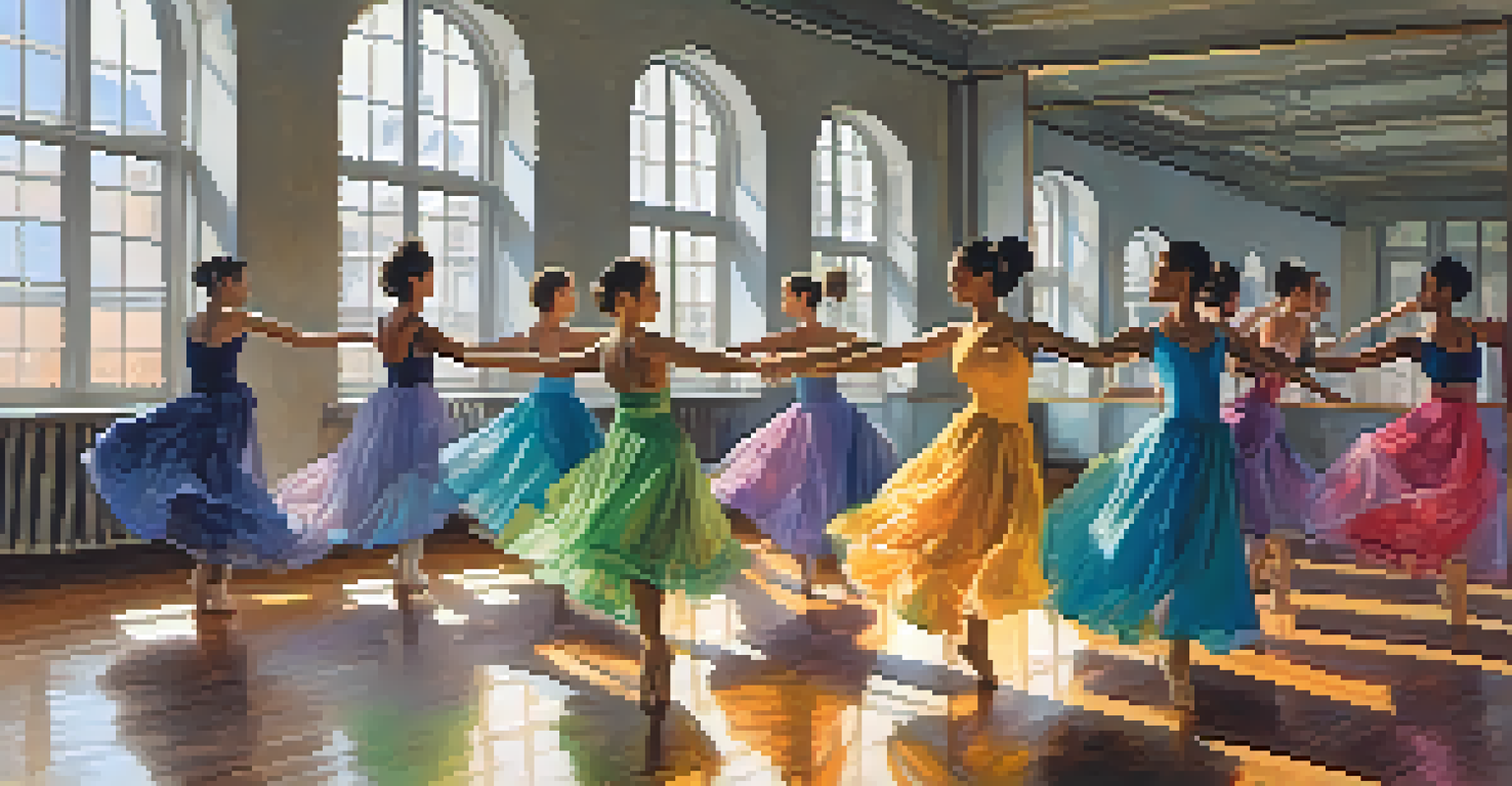How Confidence Affects Performance Anxiety in Dancers

Understanding Performance Anxiety in Dancers
Performance anxiety is a common experience among dancers, often manifesting as nervousness or fear before a performance. This anxiety can stem from a variety of factors, including the pressure to succeed and the desire for audience approval. When dancers step onto the stage, they may feel overwhelmed, leading to a decline in their ability to perform. Recognizing this anxiety is the first step in addressing it effectively.
Dancing is like dreaming with your feet!
For many dancers, the stakes feel incredibly high, especially when they are preparing for competitions or important recitals. The fear of making mistakes or not meeting expectations can create a mental block that hampers performance. This is where the interplay between confidence and anxiety becomes crucial. The more confident a dancer feels, the less likely they are to be paralyzed by anxiety.
A dancer's mindset plays a pivotal role in shaping their experience on stage. Those who view performance as an opportunity to express themselves often experience less anxiety compared to those who fixate on the fear of judgment. By shifting their focus from external validation to internal satisfaction, dancers can alleviate some of the pressure they feel.
The Role of Confidence in Dance
Confidence in dancing is not merely about believing in one's abilities; it also involves a sense of self-assuredness that can significantly influence performance. When dancers possess high confidence levels, they are more likely to take risks and explore their creativity. This, in turn, can lead to more dynamic and engaging performances that resonate with audiences.

Confidence can be cultivated through various means, such as regular practice, positive reinforcement, and setting achievable goals. These small victories build a dancer's self-esteem and create a solid foundation for tackling larger challenges. As dancers gain experience and mastery over their craft, they naturally become more confident, which helps to mitigate performance anxiety.
Performance Anxiety in Dancers
Dancers often experience performance anxiety due to pressure and fear of judgment, impacting their ability to perform.
Additionally, confidence can act as a buffer against negative thoughts and self-doubt. Dancers who believe in themselves are better equipped to handle the pressures of performing in front of an audience. This inner strength allows them to focus on their movements rather than the fear of failure.
Techniques to Build Confidence in Dancers
Building confidence is a journey, and there are several techniques dancers can employ to bolster their self-assurance. Visualization is one such technique; by mentally rehearsing their performance and envisioning success, dancers can create a positive mindset. This mental preparation can lead to improved performance and reduced anxiety on stage.
You can’t be afraid to be wrong. It’s the only way you’ll learn.
Another effective approach is the practice of mindfulness and breathing exercises. These techniques help dancers center themselves and manage their nerves before stepping into the spotlight. By focusing on their breath and being present in the moment, they can diminish anxiety and enhance their confidence.
Finally, seeking constructive feedback from instructors and peers can also play a vital role in building confidence. Understanding areas of strength and opportunities for growth helps dancers develop a more balanced view of their abilities, fostering a stronger sense of self-worth.
The Impact of Positive Self-Talk
Positive self-talk can be a game-changer for dancers struggling with performance anxiety. Encouraging internal dialogue can help counteract negative thoughts that often accompany anxiety. Instead of thinking, 'I will mess up,' a dancer might replace that with, 'I am prepared, and I will give my best performance.'
This shift in mindset creates a more supportive mental environment, allowing dancers to feel empowered rather than defeated by their anxiety. Over time, this practice can become a habit, making it easier for dancers to enter a confident state of mind before a performance.
Building Confidence is Key
Cultivating confidence through practice, positive self-talk, and feedback helps dancers mitigate anxiety and enhance performance.
Moreover, surrounding oneself with supportive peers can enhance the effects of positive self-talk. When dancers share affirmations with each other, they create a community that uplifts and encourages, further solidifying their confidence.
The Connection Between Confidence and Body Language
Body language plays a crucial role in how confidence is perceived, both by the dancer and the audience. A dancer who stands tall, maintains eye contact, and moves with purpose sends a message of self-assurance. This outward display not only influences how others perceive them but can also reinforce their own feelings of confidence.
Conversely, closed-off body language can signal insecurity and amplify performance anxiety. Dancers who hunch their shoulders or avoid eye contact may inadvertently increase their feelings of self-doubt. By consciously adopting confident body language, dancers can create a positive feedback loop that boosts their performance.
Practicing body language techniques in rehearsals can help dancers feel more at ease during performances. By integrating these strategies into their routine, they can develop a strong presence on stage that reflects their inner confidence.
The Role of Experience in Reducing Anxiety
Experience is a powerful teacher in the world of dance, and it can significantly impact performance anxiety levels. As dancers accumulate more performances, they often find that their anxiety decreases over time. This reduction is largely due to the familiarity that comes with practice and exposure.
Each performance provides an opportunity for growth and learning, helping dancers refine their skills and build confidence. By reflecting on past performances, they can identify what worked well and what could be improved, creating a sense of mastery over their craft.
Supportive Environments Matter
Creating a nurturing atmosphere among instructors and peers fosters confidence and reduces performance anxiety for dancers.
Furthermore, experienced dancers tend to develop a more resilient mindset. They learn to embrace challenges and view mistakes as part of the learning process, which can help alleviate anxiety in future performances.
Creating a Supportive Environment for Dancers
A supportive environment is essential for fostering confidence and reducing performance anxiety in dancers. Instructors, peers, and family members play an integral role in creating a nurturing atmosphere that encourages growth. When dancers feel safe to express themselves and take risks, they are more likely to thrive.
Open communication is key in establishing this supportive environment. Instructors who provide constructive feedback and celebrate successes contribute to a dancer’s sense of belonging and self-worth. Additionally, fostering camaraderie among peers can create a team dynamic that alleviates individual pressure.

Ultimately, when dancers are surrounded by encouragement and understanding, they can focus on their art rather than the fear of judgment. This supportive network not only enhances confidence but also cultivates a lifelong love for dance.